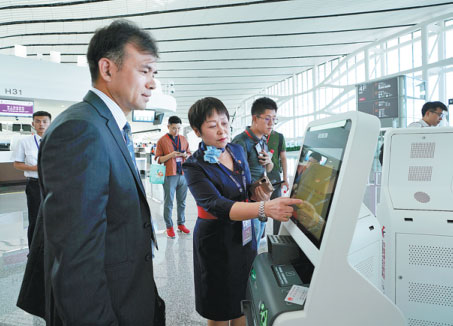Beijing's new travel hub off to a flying start
Beijing's new mega airport, which resembles a phoenix spreading its wings, took off in late September to welcome passengers from home and abroad.
Beijing Daxing International Airport, one of the world's largest, covers a terminal area of 700,000 square meters - equivalent to the size of 98 soccer fields - and is expected to handle 45 million passenger trips a year by 2022 and 72 million by 2025.
As of Oct 10, the airport had handled 1,237 flights and about 187,000 passenger trips - a daily average of 12,400 - according to the Civil Aviation Administration of China.
Apart from being an integrated transportation hub, the airport had been a popular tourist destination during the recent weeklong National Day holiday, attracting 470,000 visitors.
Fifteen additional carriers, including eight overseas carriers, will begin operations after October 27, which is the beginning of a new flight season.
The total budget for the airport's construction, which took just under five years to complete, came to a total of 80 billion yuan ($11.7 billion). By contrast, simply building a third runway at London Heathrow Airport is projected to cost $17 billion, and it won't be operational until 2026 at the earliest.
"We finished the the main construction projects in 10 months, which is equal to completing 25 18-story buildings every month," said Li Jinhua, project manager of the Daxing Airport's terminal construction office.
With such huge passenger volume to handle and the airport's position as an international hub, construction was no easy thing, requiring not only cutting-edge technologies but also advanced and creative design.
The new airport has one large terminal, with 268 aircraft parking bays and a total of four runways - three north to south and one west to east - which is the first of its kind in the nation. The pattern will help reduce delays.
The airport also employs stateof-the-art technologies, which can guarantee taking off and landing with a runway visual range of 75 meters and a minimum approach of less than 15 meters.
This means the airport has obtained the world's leading capability in ensuring safe flight in conditions of low visibility. As a result, flight delays caused by fog, smog and other unfavorable weather conditions will be reduced and on-time flight performance will improve.
Previous to the new airport's opening, Beijing Capital International Airport, the world's secondbusiest in terms of passenger volume, was the nation's only airport to allow takeoff with a runway visual range of 90 meters.
The Daxing airport's docking system ensures safe and efficient aircraft movements for the airport as well. It has various functions including automatic route planning and automated light guiding, which will help the new airport to streamline operations by reducing controller-pilot communications and runway occupancy time.
Nicknamed the "starfish" for its shape of five concourses connected to a main hall, the Daxing airport aims to reduce walking time for passengers, addressing a common complaint about many new megahubs around the world.
Guo Yanchi, chief engineer in charge of the construction work, said the terminal was designed to shorten the walking distance for passengers while providing as many aprons for aircraft as possible.
"It is only 600 meters, or less than an eight-minute walk, from the center of the terminal to the farthest boarding gate in each wing. Despite the expansive design, it's more efficient for the passengers than any other large airport terminal of the same size in the world," he said.
The airport, as an environmentally friendly facility, has also adopted green and energy-saving concepts to incorporate natural light and seamless steel structure in its terminal design.
The sleek, modern interior design is striking, thanks in part to the 8,000 distinct rooftop windows that allow in the sun's rays. The atrium of the terminal is supported by eight giant C-shaped columns, each with a 106-meter-wide skylight at the top, which fills the terminal with natural light.
To put that into perspective, it saves over 70 percent on lighting facilities compared with Beijing Capital International Airport, which uses more than 20,000 lamps. It can save about 8,850 tons of coal and reduce 22,000 tons of carbon dioxide emissions annually.
The new airport, situated around 50 km to the south of the Beijing city center on the Chinese capital's traditional north-south central axis, will be accessible via new subway line Daxing Airport Express, high-speed rail and intercity rail.
In order to house the railway, subway and airport express trains that pass beneath the airport complex - with trains running at 250 kilometers per hour - anti-seismic technology invented by Beijing Urban Construction Group was used. More than 1,150 anti-seismic pillars were built. Therefore, the new airport can withstand a magnitude-8 earthquake, making it the world's largest single anti-seismic building.
Beijing Daxing International Airport also has embraced multiple new technologies to make it smarter and more efficient.
The adoption of the latest smart technologies - including self check-in and bag-drop kiosks, facial recognition technology and radiofrequency identification technology for luggage tracking - will allow passengers to have a quicker, more seamless check-in and boarding process.
When the mega airport reaches its full operational capacity, 100 million passengers are forecast to go through the airport annually, a number that will approach that of Hartsfield-Jackson Atlanta International Airport in the United States - the world's busiest airport in terms of passenger traffic.

A staff member (center) helps a passenger with China Eastern Airlines' facial recognition system to get his boarding pass without showing an ID at Beijing Daxing International Airport on Sept 25. [Photo by Ju Huanzong in Xinhua]

